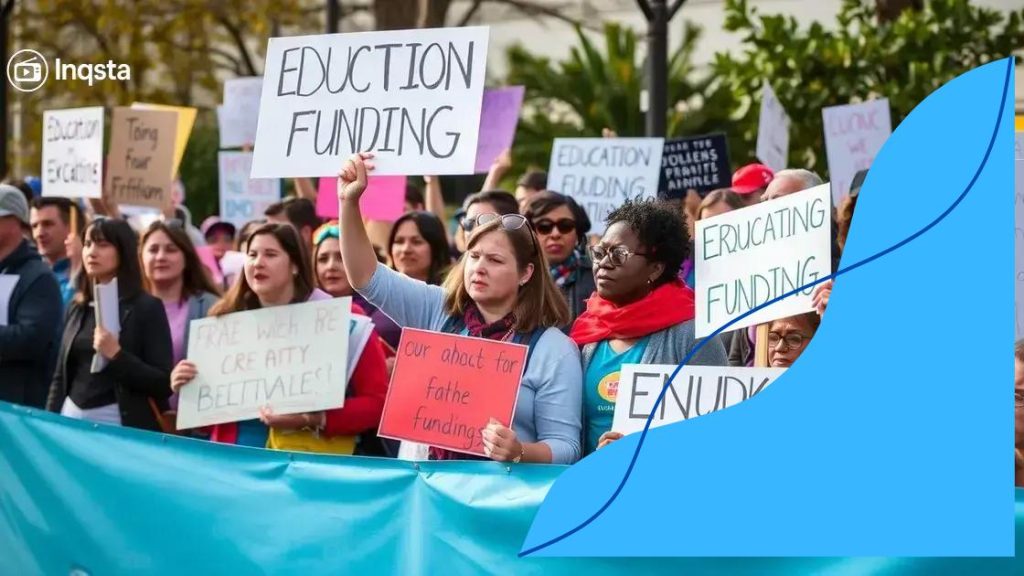NEA protests federal education cuts as schools face crisis

Anúncios
NEA protests federal education cuts demand increased funding, better teacher pay, and essential resources for students, aiming to address inequities faced by schools in underserved communities.
NEA protests federal education cuts are making waves across the country, stirring conversations about the future of public schooling. Have you considered how these cuts might affect your local education system? Let’s dive into the details.
Anúncios
The background of NEA protests
The background of NEA protests is rooted in years of educational budget cuts and policy changes that have challenged teachers and students alike. These protests are not just about funding; they represent a larger movement advocating for quality education for all. In understanding these protests, we see the passion behind the demand for better resources and support.
The Rise of Funding Cuts
Over the past decade, many states have experienced significant funding cuts to education. This has led to overcrowded classrooms, outdated materials, and dwindling teacher salaries. As educators are pressured to do more with less, the NEA protests have gained momentum, highlighting these critical issues.
What Drives the Protests?
There are several key factors that drive the NEA protests:
Anúncios
- Demand for equitable funding across districts.
- Calling attention to teacher burnout and attrition rates.
- Advocating for student resources such as mental health services.
- Highlighting the importance of community support in education.
These reasons reflect broader societal concerns about education’s future. As teachers and advocates gather, their united voices call for a system that invests in students and educators.
Attending these protests not only raises awareness but also fosters a community of support, encouraging others to join the cause. As education continues to face challenges, it is essential for the community to remain engaged and advocate for the changes needed.
Public Response to Protests
The public response to these protests has varied. Many community members support the educators, recognizing the importance of their fight. Others may not fully understand the depth of the issues at stake. Conversations initiated by these protests are helping to bridge these gaps in understanding.
Through discussions between teachers, parents, and lawmakers, the hope is to find common ground. With a growing awareness of the impact of underfunding, more individuals are beginning to support initiatives that could lead to positive change in education.
Key issues raised by educators
Several key issues raised by educators during the NEA protests highlight the challenges they face daily. These concerns reflect the urgent need for changes in the education system and better support for both teachers and students.
Funding Inequities
One of the most pressing issues is the inequitable distribution of funding. Many schools in low-income areas struggle to provide basic resources. This affects everything from classroom supplies to extracurricular activities.
Teacher Salaries and Conditions
Another major concern is the low salaries that many teachers receive. Many educators feel undervalued for their hard work and dedication. Poor working conditions also add to their struggles, leading to higher turnover rates.
- High student-to-teacher ratios.
- Lack of access to professional development opportunities.
- Emotional burnout from high-stress environments.
- Insufficient classroom support staff.
These elements contribute to a challenging workplace, reducing the overall effectiveness of educators. Many teachers have reported feeling overwhelmed and unsupported in their roles.
Additionally, the lack of resources for student mental health services is alarming. Many students face emotional and psychological challenges, especially in today’s environment. Educators are advocating for increased access to these vital services.
Curriculum Concerns
The curriculum itself is also a significant issue. Many teachers advocate for a curriculum that better reflects the needs of today’s students. This includes integrating technology and addressing social issues within the classroom.
As the education landscape evolves, educators emphasize the importance of adapting teaching methods and materials. They argue that a responsive curriculum is essential for engaging students and preparing them for the future.
Impact on federal education funding

The impact on federal education funding is a crucial topic in discussions surrounding the NEA protests. Cuts to funding have significant consequences for schools across the nation. Understanding these impacts helps illuminate the reasons behind the protests.
Funding Cuts and Their Consequences
Federal funding cuts can lead to reduced resources for schools. This means fewer supplies, less technology, and diminished support staff. When schools operate with limited budgets, it can affect classroom sizes and the quality of education.
Effects on Classroom Resources
Teachers often find themselves purchasing materials out of their own pockets. Many struggle to provide essential tools for their students. The lack of basic resources can hinder a student’s ability to learn effectively.
- Outdated textbooks that don’t align with current standards.
- Limited access to technology such as computers and smart boards.
- Fewer extracurricular programs that engage students.
- The inability to hire enough staff to support student needs.
Moreover, the consequences extend beyond just resources. Students in impoverished areas may suffer the most when funding is slashed. They often attend schools that lack essential programs and support services.
Without adequate funding, schools cannot provide the services that many students need, such as counseling or career guidance. This creates a ripple effect that impacts student success and future opportunities.
The Role of Federal Policies
Federal policies also play a significant role in education funding. Changing legislation can either enhance or diminish support for schools. It’s crucial for educators and advocates to stay informed about these policies.
The NEA protests aim to bring awareness to these critical issues. By highlighting the need for adequate federal education funding, they hope to inspire action and change.
Responses from lawmakers and educators
The responses from lawmakers and educators to the NEA protests reveal a complex interaction between various stakeholders in education. As protests escalate, both groups are becoming more vocal about their needs and concerns.
Lawmakers’ Reactions
Many lawmakers have publicly acknowledged the protests, though their responses vary. Some express support for teachers, recognizing the challenges they face. Others may offer dismissive comments or promise future funding without clear commitments.
- Support for measures to increase education funding.
- Caution about the implications of budget decisions.
- Calls for community involvement in decision-making.
- Efforts to clarify education policies impacted by the protests.
These responses highlight the need for ongoing dialogue between educators and those in positions of power. While some lawmakers attempt to engage with teachers, others remain disconnected from the issues at hand.
Educators’ Perspectives
Educators are responding strongly to these protests. Many are frustrated by politicians’ promises that do not translate into tangible changes. They stress the urgency of addressing funding cuts and inadequate support systems.
As teachers organize and articulate their grievances, they advocate for specific changes, including improved pay, smaller class sizes, and better mental health resources for students. This collective effort serves to amplify their voices in the political arena, seeking meaningful legislation.
The dialogue is essential. Educators hope that by bringing their experiences to the forefront, lawmakers will better understand the day-to-day realities faced in classrooms. The call for action is not only for better funding but also for a more equitable education system that serves all students.
Future implications for schools
The future implications for schools hinge on the outcomes of the NEA protests and the responses from policymakers. As these protests continue to gain attention, they bring to light crucial issues facing the education system. Understanding these implications is vital for anticipating changes that may affect students and educators alike.
Potential Changes in Funding
If lawmakers respond positively to the protests, schools may see an increase in funding. This could lead to smaller class sizes, new technology, and better resources. Increased funding would benefit not only teachers but also improve the learning environment for students.
Shift in Educational Policies
There may also be a shift in educational policies as a result of these movements. Lawmakers could introduce laws that ensure better funding equity among schools. Ensuring all schools receive adequate resources is essential for a fair education.
- Emphasis on mental health resources for students.
- Increased support for special education programs.
- Greater focus on teacher pay and retention strategies.
- Enhanced community involvement in schools.
As discussions around educational equity deepen, schools might undergo structural changes that place student needs at the center of policy-making. Communities could see more support and resources allocated to underserved areas.
Furthermore, educators may benefit from increased collaboration with lawmakers. This partnership can create a comprehensive approach to addressing the challenges within schools. If educators are actively involved in the policy-making process, the changes implemented are likely to be more effective.
Long-Term Benefits for Students
The long-term benefits for students could be significant. A well-funded, equitable education system can lead to improved academic outcomes and better preparation for future challenges. Students may have access to a wider range of learning opportunities that cater to their diverse interests and needs.
Ultimately, the future implications for schools will largely depend on the outcomes of these protests and how society chooses to prioritize education. Engaging in conversations about education and advocating for necessary changes will shape the path forward.
The NEA protests represent a crucial moment for education in the U.S. By highlighting the challenges faced by teachers and students, these protests call for necessary changes to federal education policies and funding. Lawmakers must listen to the voices of educators and respond to their needs. If effective actions are taken, schools can transform, providing better resources and support for all students. The future of education will rely on the collaboration between educators, communities, and policymakers. Everyone has a role in shaping a fair and equitable educational landscape.
FAQ – Questions about NEA Protests and Federal Education Cuts
What are the main goals of the NEA protests?
The main goals of the NEA protests are to demand increased funding for education, better teacher pay, and resources for students, especially in underserved communities.
How do federal education cuts affect schools?
Federal education cuts can lead to overcrowded classrooms, outdated materials, and a lack of essential services, negatively impacting both teachers and students.
What role do lawmakers play in education funding?
Lawmakers influence education funding through legislation and budget decisions. Their support or opposition can significantly affect resources available to schools.
How can communities support these protests?
Communities can support the protests by advocating for better education policies, attending rallies, and engaging in discussions about the importance of funding equity in schools.